 Missile Frigate built 1979-85, pending decommission
Missile Frigate built 1979-85, pending decommission
Other names: Muntenia as built, Timișoara 1990, Mărășești (F111) 1986, active.
Currently no longer the Romanian flagship from 2004, a role taken by Regele Ferdinand (formerly HMS Coventry), the Romanian frigate Mărășești was quite an achievement for the Romanian shipbuilding industry and techno-military complex in the cold war. In the move to take distance with Moskow (albeit still part of the Warsaw Pact unlike Yugoslavia), Romania under dictator Nicolae Ceaușescu, embarked in a program of militaro-industrial independence from USSR in procurement, and many projects were launched on the late 1970s and early 1980s regarding all three branches. The results of these endeavours for the Army were the TR-85 main battle tanks, MLI-84 IFV, and TAB series of APC among others, but also artillery, mortars and small arms. For the Air force, the IAR-93 Vultur or more recently the IAR 99 Standard/Șoim and IAR 316B and 330 helicopters.
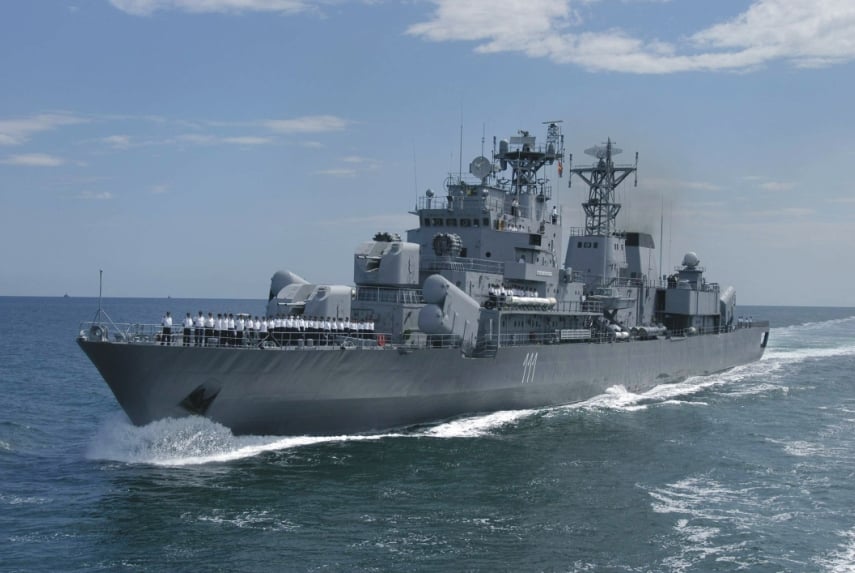
For the Navy, equipped in the 1970s with Soviet vessels (Poti class corvettes, OSA; Tarantul, Kronstadt/Shanghai OPVs…) there was an ambitious plan, not only to give the country a national military procurement option, but also bolster the Navy with first-rate missile frigates, destroyers and submarines. The result, among other vessels such as the small Tetal class frigates, was Mărășești, which by size at the time was classed as a missile destroyer and quite unique in many aspects. This was probably the largest non-Soviet surface ship built within the Warsaw Pact. built at Mangalia Yard and flagship for three decades of the Romanian fleet at Constanța, she is still in service today, her last upgrade dating back from 2008.
Development
Context
1964 a rift started to form between Romania and the USSR. First Nicolae Ceaușescu refuse to sever relations with China or accept COMECON plans for economic development, then taking an independent line in trade relations, and refusing take part in the invasion of Czechoslovakia in 1968. As a result Soviet supplies dwindled, leaving the Romanian Navy weakened with just three ‘Poti” class corvettes (1970) an five Osa classFACs to defend her Western black sea coast. Chinese assistance was willingly invited, Huchuan hydrfoils and Shanghai OPVs were licenced (25 and 30 commissioned late 1970s). Bucharest’s ambitions for independence gave President Ceaucescu a major concentration of power into his own hands to oversee major projects, which however soon turned at odds with the capacity of the Romanian economy, and yet seeing the most spectacular naval expansion programme undertaken.
The country indeed wanted at least two missile destroyers (“battlecruisers”), four frigates, twelve torpedo craft, two large auxiliaries all built domestically, and at least four attack submarine. When the latter proved particularly hazardous, having so little experience, lost for decades, a Kilo class was purchased in 1986 from the Soviet Union. The ships were fitted with however with outdated weapons and sensors from the Soviet Union. Construction of such a large fleet and other grandiose projects created a cost inbalance unlike anywhere in Europe which combined with declining living standards and other effects, until a general collapse of the economy. Naval shipbuilding was stopped completely in 1987, just one year after the first of these “battlecruisers” was completed, at great cost and considerable efforts. Long story short, the program bankrupted the country, and in 1989 prompted a revolution that ousted the 22 years ruling “conducator”.
Final design and construction 1982-1985
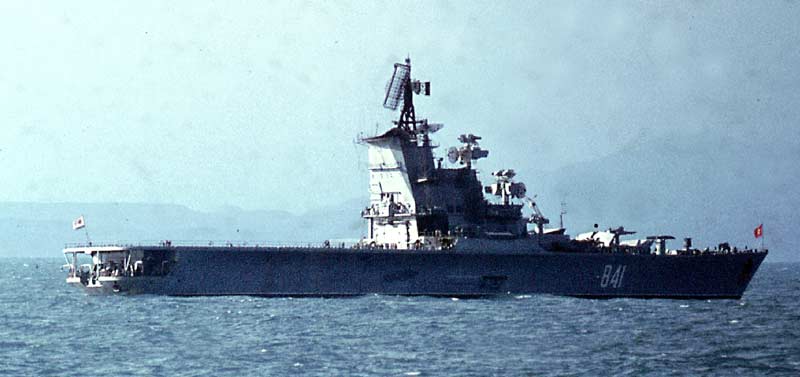
The Moksva class, initial inspiration for the first design in 1976.
The Nicolae Ceaușescu started working on initial specifications of large missile ships to be built at the 2 May Naval Shipyard (Santierul 2. Mai) in Mangalia, Black Sea coast in 1975. The Yard at the time, only managed to create light frigate design, the Amiral Petre Bărbuneanu (Tetal) class, but nevertheless, technical teams were mobilized to work on a large missile destroyer, with the objectives of having plans ready in 1978.
The design committed only Romanian engineers, no foreign specialists. As the hull was designed it was soon obvious, that having no R&D infrastructure to develop radars and modern weaponry was a severe drawback. Delays were announced, since everything was to be done from scratch up to ten years. Eventually, all weapon systems and electronic equipment would be ordered to the Soviet Union. And that had consequences, as Soviet policy on exports meant only older and/or downgraded systems were authorized. The large marine diesel engines to power the ships were unlike nothing the country could produce at the time as well, neither a gas turbine. These too, had to be ordered in the Soviet Union, but they were not optimal for such large vessels.

The Tetal or Amiral Petre Bărbuneanu class was the only experience of the Mangalia yard when designing the destroyer
It was initially intended to build a hybrid missile destroyer/helicopter carrier, somewhat a Romanian version of the Moskva class, but lack of experience in building large ships in Romania had the initial concept shelved off. The original ship was still built according to plan, at least capable of carrying two light helicopters which was a firm specification from the start. The 8,000 tonne design was scaled down gradually until reaching 4,500t. Still, as she was laid down in 1979, this became the largest ship ever built in Romania, with the second ship planned later abandoned due to rising costs and the final collapse of Ceaușescu regime. Plans were ready in 1979, which was remarkable given the relatively short time in which they were drawn.
Design of the class

Conway’s profile as built, 1985
With such independent development, unique features were adopted either for construction or naval architecture, and having a few references around, it was decided the beast approach was to create a flush deck design with high freeboard, slight bow sheer adapted to the black sea. Retrospectively the high freeboard about 7 meters at the bow and, 6 meters amidships was probably too much for the shallow waters of the area. There was a moderately sloped stem, blunt when viewed from above, and longitudinal bend for the sides almost to the middle of the length to creat fine lines. Inspired by novel civilian construction, there was also a bulbous bow to reduce drag. The whole underwater hull design was however derived from the Tetal class, just upscaled, and not successful as on trials, waves were generated at low speeds.

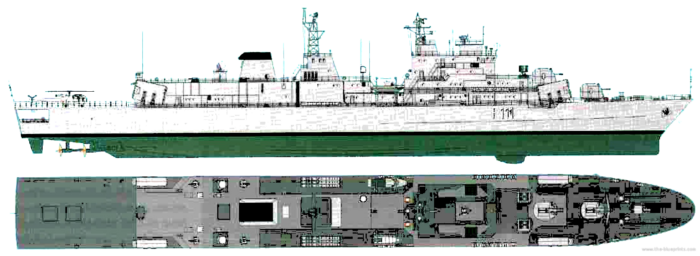
Post-1992 refit design (the blueprints)
Above the hull, superstructures were two large blocks, separated amidships buy a smaller structure service boats under davits. The most impressive was the bridge, a large multi-story boxy structure that was impressive in appearance but unnecessary. It came in stark contrast with the very sleek, low-slung Tetal class Frigates. The two main gun turrets AK-726 turret were also placed in a classic wat, with the first on foredeck, second in superfiring position, first floor of the superstructure. On tirther side of the bridge were placed two forward fixed two-canister missile launchers.
The depth charge rocket launchers were located on a second platform ender the navigation bridge proper. The bridge itsef was three faceted and relatively narrow, with wings, and the roof had a box superstructure over which was placed the Soviet-built fire-control radar. The rear part of the bridge supported the forward mast, with a rigid strtucture topped by a derrick and supporting the main navigation radar.
Tthe second superstructure was lower and longer, ending with the helicopter hangar. The forward part there supported the aft lattice mast, a structure dotted with windows forward topped by a derrive and main aerial. Aft of it was the single blocky funnel. There an another pair of large, double anti-ship missile launcher containers (similar to those of the Tarantul class corvettes) both sides of the aft superstructure, angled upward. Originally, the fore launchers were mounted on the deck of the first floor, behind the superfiring AK-726 turret but after reconstruction, they ended on the upper deck, on both sides of the superfiring turret. The helipad was generous, and behind was the working half-deck cut out in the hull having mooring and anchor capstans but no VDS. The transom stern completed the picture. No data is available on the way both the hull and structures were built, ie steel versus aliminium. It seems the ships were all-steel, meaning somewhat unstable but at least fire proof.
Hull and general design
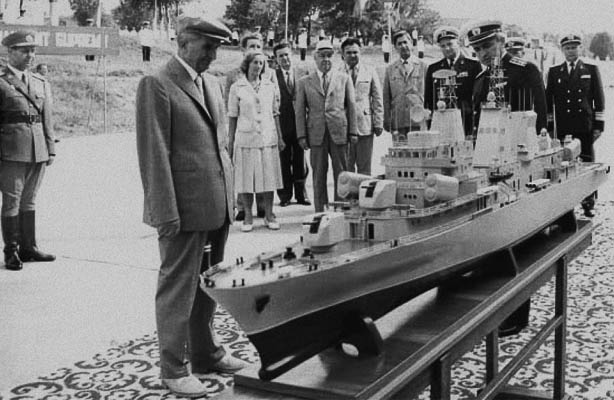
Muntenia’s model presented by an admiral to Ceaucescu in 1978.
Standard displacement of the Muntenia in 2006 rose to 4,754 tonnes (4,679 long tons), full displacement 5,790 tonnes (5,700 long tons). Originally prior to her 1988-92 reconstruction, it was allegedly 4500/4790t, so quite a rise. Dimensions did not changed however, with an overall lenght of 144.6 m (474 ft) long, 14.8 m (49 ft) in width (so 1/10 ratio) and draught of 4.9 m (16 ft), which was coherent with the rest. Her crew, for such a size, was reduced, just 233 personnel, including 22 officers, 72 non-commissioned officers and 139 sailors. After 2004 it was reported aorund 270, including 25 officers. Since these had presumably a low level of automation, with their armaments and sensors basically derived from the Tanantul class corvettes, she might had been felt roomy inside, and thus open to future ugrades, however she was woefully underarmed for her size and completely lacked modern ASW capabilities, helicopters, RBU launchers and torpedo tubes not being completed by a modern, large sonar and VDS. At best she had close range detection, and the helicopters were not designed for ASW detection anyway, more for reconnaaissance, SAR and liaison (see below).
Powerplant
The choice of diesels was also dicated by what was possible at the time (The USSR would ban delivery of gas turbines), and imported from smaller vessels. These were four four-stroke, six-cylinder diesels model 61D, working independently of each other. Each of these drove four shafts via single-stage gearboxes. There were three-blade propellers. These diesels were individually rated for 8,000 hp (6,200 kW) each, for a total of 32,000 hp. Outer shaft propellers had adjustable pitch (forward engine room), inner had a fixed pitch (aft engine room) but all shafts had the same length, so the outer propellers were closer to the bow than the inner ones, causing some disurbance in the water flow. There were two apron rudders behind the propellers as well. That diesel-propeller arrangement needed constant adjustment to avoid imbalance and was not optimal for flexibility, albeit the diesels took a bit less space. In addition to power all systems when the diesels were cold, they had four diesel-electric generators rated for a total of 2800 kW.
Top speed in most publications is about 27 knots (50 km/h) tup to 28 knots with Conways generously giving them 32 knots back in the 1990s. The range was noted at 2,800 nautical miles (5,200 km) at 12 knots (22 km/h), 1,500 nautical miles (2,800 km) at 25 knots (46 km/h) which was adpated to the format of the black sea and Mediterranean.
Armament
P-15M (SS-N-2C) SSM
The Muntenia was originally design for classic ship-toship combat, having no SAM or long range ASW detection. The battery comprised four P-20M guided-missile complex, Soviet built. Each comprised a canister for the P-21 anti-ship missiles, export version, having an active radar head. The canisters could also receive the P-22 with a passive thermal homing head. The canisters were installed inside four KT-138E fixed double container-launchers making for a total of eight missiles directed forward and aft. They were directed by the Koral-E system. This was double the missile capacity of the Project 1241E Tarantul missile corvettes. But these were short range for such large vessels.
There was a radar station for the Garpun-E target detection radar added in the 1990s.
⚙ specifications P15M |
|
| Weight | 2,580 kg (5,690 lb) |
| Dimensions | 5.8 x 0.76 x 2.4 m (19 x 2 ft 6 in x 7 ft 10 in) |
| Propulsion | Liquid-propellant rocket, solid-propellant rocket booster |
| Speed | Mach 0.95 |
| Range | 80 kilometres (50 mi) |
| Guidance | INS, active radar homing, supplemented IR homing |
| Ceiling | 25 to 100 metres (82 to 328 ft) |
| Payload | 454 kg (1,001 lb) hollow charge high explosive |
SAMs
Originally these vessels received no anti-aircraft missile launcher, despite the availability of the Soviet 4K33 Osa-M short-range missile launcher, and it was perhaps a combination of short sightedness from Caucescu, export concerns, or economical reasons. In 1990s at last two quadruple Fasta-4M/2 launchers were installed, capable of launcher the 9K32M Strela-2M infrared homing short-range anti-aircraft missiles. These were used on army vehicles already. But as just glorified MANPADS they were obsolete at that range, having a max range of just 2,800 m and ceiling up to 2,300 m. They were likely installed on either side of the bridge, second level aft platforms.
76 mm AK-726
The main gun ZIF-67 turrets were twin 76.2 mm AK-726 automatic complexes superfiring forward. They were known systems used by the Romanian navy and also abord the Tetal class frigates, albeit fore and aft. They were guided by the MR-105 Turiel radar. Ammunition supply was 1,600 rounds per turret, range is 13 km on surface, 9 km ceiling, rate of fire 90 rounds/minutes per barrel. They were efficient against relatively slow incoming aicraft and helicopter, less so against Mach 1 jets.
30 mm AK-630M
In 1986 the ships received four twin-barrel 30 mm AK-230 cannon turrets with MR-104 Ryś radars placed along the longitudinal axis. This was completed by a single twin 14.5 mm HMG mount, which placement is obscure. They were only close defence, but slow firing/moving assets and a poor protection against incoming missiles with the absence of any ECM or decoys. To the standards of the 1980s, especially compared to Ticonderoga class cruisers, this was woefully unsufficient.
In the 1990s, four 30 mm AK-630M, each six-barrel automatic cannons were adopted for close-in defence. The turrets were located on the aft structure, two between the aft mast and funnel, two on the hangar’s roof. For an efficient point-blank defense they were guided by two MR-123 Wympiel fire control systems placed also on the hangar’s roof, forward of the aft CIWS pair. They were doubled by the turret’s own Kolonek backup electro-optical sights.
RBU 6000
The anti-submarine armament mostly depended on classic recipes or torpedoes and rocket launchers. There were at first two 16-barrel RBU-2500 Smerch-1 launchers which were manually loaded, quite an oddity in 1985. In the 1990s refit, they were replaced by two RBU-6000 Smerch-2 depth charge rocket launchers, placed high up on the fore superstructure. They were reloaded automatically from below deck. All this however created extra top weight. Range was 6 km, weight of each rocket’s warhead just 31 kg.
Torpedoes
From 1985 to this day they kept two triple 533.4 mm torpedo tubes on either side amidships with just enough traverse to fire overboard forward their 53-65K torpedoes or SET-53 anti-submarine torpedoes. See soviet entries for specifics of both.
Helicopters
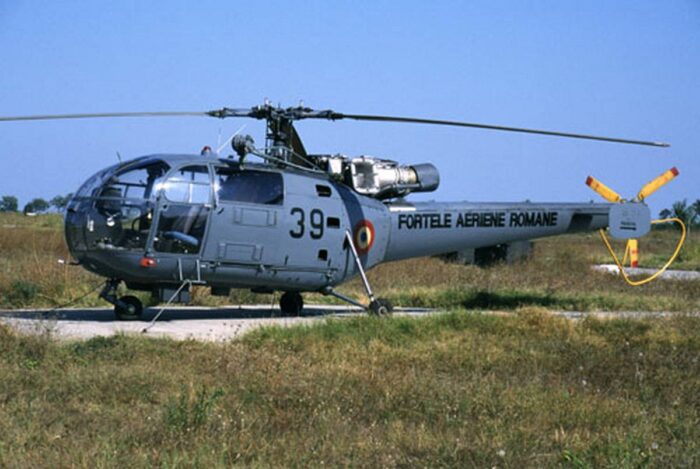
IAR-316B in “marine livery”. Note that they had the RoAF marks as there was no independent Romanian naval air arm. RoAF ground models were camouflaged.
Mărășești’s hangar at the erar was large enough to accommodate two IAR 316B light helicopters, wich were license-built French Aérospatiale Alouette III and obsolescent in 1986. They were replaced with a single IAR 330 Puma Naval (navalized licensed version of the Aérospatiale Puma which first flew in 2007) which had much greater capabilities of speed, range and payload.
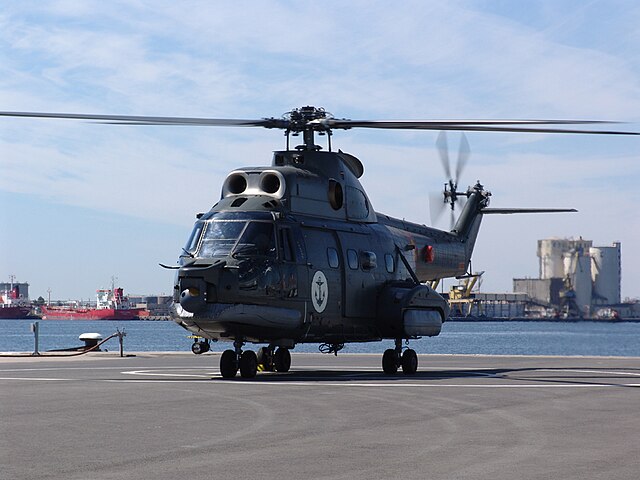
The IAR 330 was the Romanian version of the Puma which licenced was acquired in 1974, and in service by 1975 mostly by the RoAF and Army. In 2004 a navalized version (rather unique as the helicopter wa sinitially designed as a pure army model) was created to answer the need of the Romanian Navy and replaced the obsolete IAR 136Bs on Muntenia/Timisoara. 3 were built between 2005 and 2008, with further trials and upgrades up to 2015. They had the SOCAT upgrade package but a flotation gear housed underneath the nose and main undercarriage fairings. They had mission-specific avionics supplied by Thales and were used for SAR, medevac, maritime surveillance, without ASW capabiliies.
Sensors
The Marasesti’s/Munetnia sensors suite was entirely of Soviet origin:
-MR-302 Rubka: General surveillance mounted on the froward mast, used for target detection also. Range of up to 98 km air, 30 km sea. In 1990s, moved to the aft mast.
-Don-2 navigational radar.
–Garpun-E: In the 1990s this radiolocation station was added to the forward mast, sea targets for P-20M missiles.
-MR-105 Turiel FCS: For AK-726 cannons, located aft on the hangar.
-MR-104 Ryś: for AK-230 cannons, aft structure, superfiring
-MR-123 Wympiel: (1990s), for AK-630 cannons.
-MG-322 Argun sonar: Fixed underhull station to detect submarines.
-Zaliv 13-14/Zaliv 14-15 Communication antennas sets on the stern mast
-Nikiel-KM: Identification system.
In 2001, with integration into NATO standards her electronics were modernized, with adoption of a digital communication and identification system Bundermarine Mk XII from Aeromaritime Systembau. GPS and satellite communication wa sinstalled as well as a Link 14 standard data exchange link, plus the KWR-46 concealment device and Racal Decca navigational radar. Still, she received no ECM suite or chaff launchers.
⚙ specifications |
|
| Displacement | 4,754 t (4,679 long tons) standard, 5,790 t (5,700 long tons) full |
| Dimensions | 144.6 x 14.8 x 4.9 m (474 ft 5 in x 48 ft 7 in x 16 ft 1 in) |
| Propulsion | 4× Diesel engines, 8,440 bhp (6,290 kW) |
| Speed | 27 knots (50 km/h; 31 mph) |
| Range | 2,800 nautical miles (5,200 km) at 12 knots (22 km/h) |
| Armament | 2×2 76 mm AK-726, 4×30 mm AK-630M CIWS, 4×2 P-15M SSM, 2× RBU-6000, 2×3 533 mm TTs, Mines |
| Sensors | MR-302 Rubka, Garpun-E, MR-105 Turiel, MR-123 Wympiel, MG-322 Argun, Racal Decca nav radar |
| Air Group | 1x IAR 330 Puma Naval |
| Crew | 233 |
Career of Muntenia
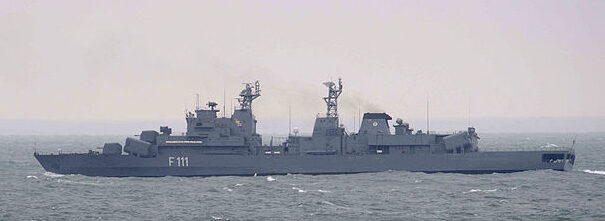
Construction started on March 1978 with her keel laid down on 7 August 1979, with conficting sources. She was launched on 4 June 1981 but fitting out took many more years with sea trials starting on 1985, and navy commission on 3 June 1985. Then final official acceptance ceremony on 2 August 1986 by Nicolae Ceaușescu which gave her the name of Muntenia, after a Romanian historical region. Official designation was “crucișător usor port-elicopter”. So still a cruiser (As of today she is a frigate, in the 1990s she was a destroyer).
Design flaws were revealed after trials and initial training. As seen on the design above, high all steel superstructures and masts and heavy rocket launchers affected badly stability. In low sea states, she starte to roll hard. In heavy weather she took some much water spreay iy even compromised the use of some weapons. Operability with the IAR 330L helicopter was asmit an afterthought and the operational “marriage” was never achieved. Apart SAR, laisons and reconnaissance, they just liked the facility to properly operate as they should, in ASW protection for the ship and vessels around. Plus they even were unable to operate on the deck on most sea conditions due to the complete absence of of roll stabilizers. After 1986-88 cruises and fixes it was obvious her defaults needed a cure, albeit stability would remain difficult to achieve.
In June 1988 she entered the yard for reconstruction, completed on 15 August 1992, and disturbed undertandably by the revolution of 1989. Modifications consisted in the following:
-Both masts shortened, bases lowered
-Funnel slightly lowered, shape thinned down
-Firward rocket launchers relocated one deck lower
-Bow superstructure adapted to the RBU-6000 launchers
-Location of radars changed.
-Armament and electronic modernized, delivered bu Russia until 1998.
-Roll bars added in drydock and perhaps some ballasting
Still she apparently was heavy with official displacement figures raised by about 250 tonnes.
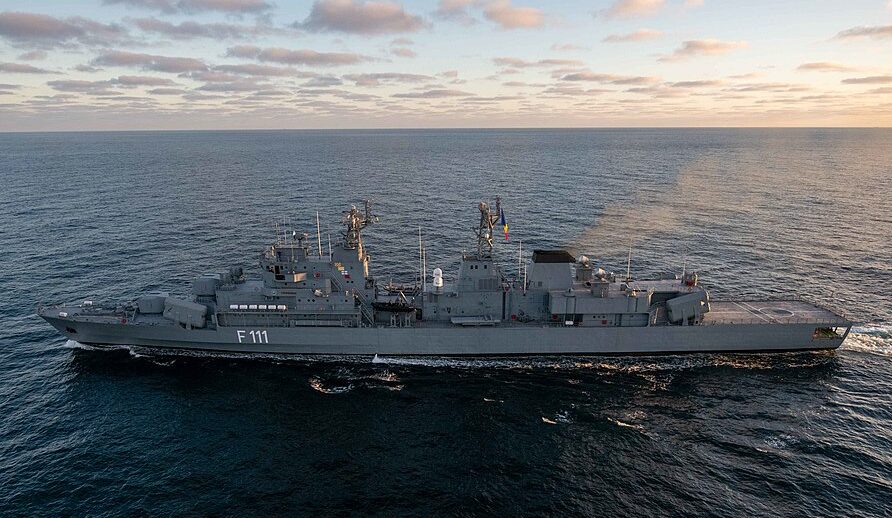
After Ceaucescus’s fled, was caught and executed on 2 May 1990, the General Staff changed both the name and classification of the shop, now a destroyer (“distrugător”), renamed Timișoara, after the city and massacre where the first protests of 1989 took place. This was only short term as she became Mărășești on 27 August 1990, after her World War 2 destroyer NMS Mărășești and named after a Romanian victory in WWI.
Maintaining this “white elephant” in the post cold war years however was put into question. Romania even offered her for sale in February 1993, (as underlined in the Conway’s 1994 edition) but since none presented as a buyer, somewhat undertsandbly, she was kept as a flagship, at least symbolic under a possible new upgrade. In September 1993, she took part in fleet maneuvers for the first time since her decommission for refit. She also made her first missile firing of the P-20M system.
She then yearly took part in numerous fleet maneuvers in the Black Sea and in 1994, in “Maritime Partner” exercises with NATO, in preparation before Romania joined the organization on March, 29, 2004 so then years afterwards. All this time was needed for the transition to NATO standards.
She started to cruise to the Mediterranean in 1994, twice in 1995 and March 1998, the same years she also participated in Strong Resolve 1998 exercise and was the first Romanian vessels to operate in the Atlantic since WW2. She still carried back then her IAR 316B of the 59th Helicopter Group Tuzla (Grupului 59 Elicoptere Tuzla) but they were difficult to operate in the average sea state despite stability measures. Still, two flights were eprformed with them over the Mediterranean, one over the Atlantic.
On 1 April 2001, Mărășești became a frigate (gr final downgrade, paradoxically as her equipments improved). This classification was a NATO standard and her new pennant was F111 from 2006, assigned to the 56th Frigate Flotilla of the Romanian Naval Forces in Constanța.
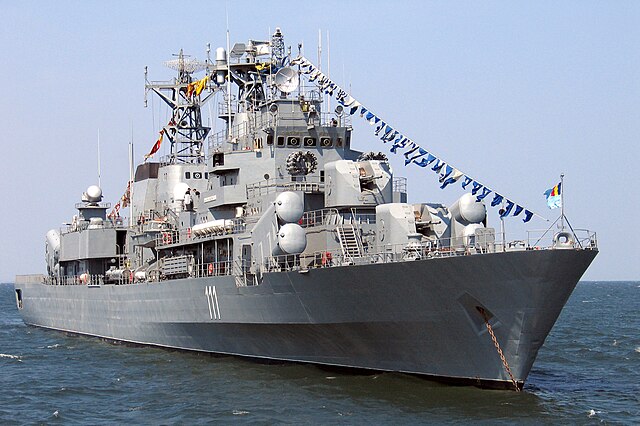
In 2007, a contract was concluded with Danish Terma A/S for a new computerized C-Flex combat management system using MFC 2000 digital operator consoles, added to the ship’s existing systems, which for many are still of the late 1970s standards. Since 2004, she was reset for missions and goas withing the fleet and NATO’s approach for the Black Sea.
Mărășești is intended to carry out peacetime missions, in crisis and war situations, under national command or within NATO, more precisely the following missions:
-Search and rescue at sea (SAR)
-Maritime interdiction operations (MIO)
-Aerial and naval surveillance
-Participation in humanitarian missions
-Naval diplomacy activities
-Protection of the Romanian EEZ, and objectives against asymmetric threats.
-Participation in the safety surounding ships and convoy escort or single operation
-Participation in evacuations of non-combatant personnel
-Surface combat
-ASW interdicition of bases and other strategic objectives
After Strong Resolve 98 in the Bay of Biscay she took part in “Storm 2000” off Bulgaria, “Cooperative Partner 2003” off Ukraine, was the first Romanian ship to act under NATO command in June 2004 during the NATO Summit in Istanbul. She took part in “Blackseafor 2005” in the Black Sea, being the first Romanian ship under command of this NATO group, sher took part in “CERTEX 2010” with Bulgaria and “Blackseafor 2010” and 2011 as commanding ship, now well drilled to NATO standards, and SEA BREEZE in 2021. She operated with ships from the US, UK, France, Belgium, Turkey, Greece, Spain, Portugal, Italy, Netherlands, Ukraine, Russia, Georgia and Bulgaria. As of 2024 her status is uncertain. She was replaced by an ex-British missile destroyer, Regele Ferdinand, as flagship.
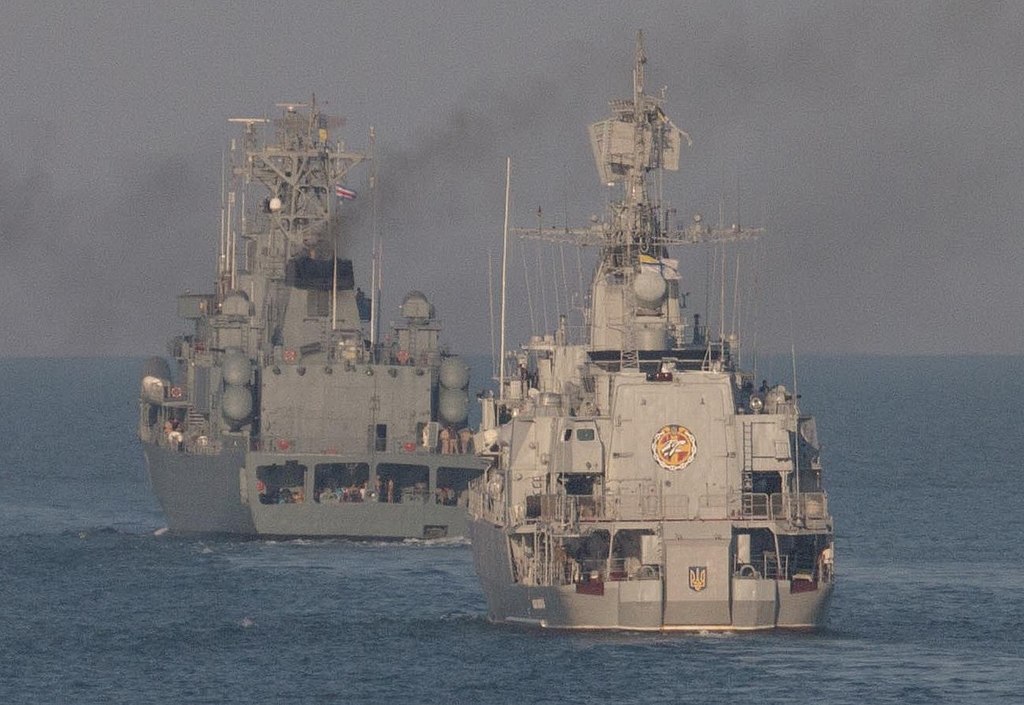
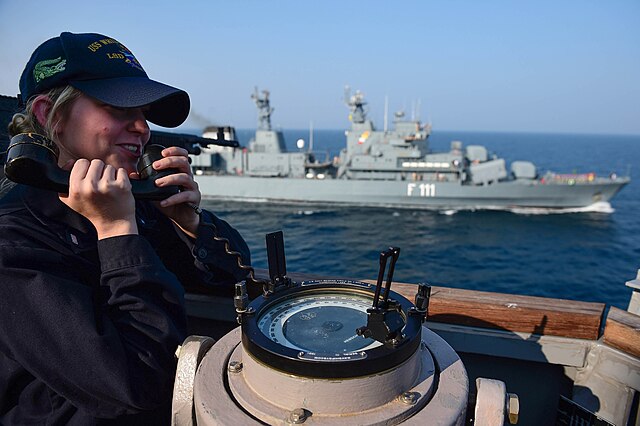
BLACK SEA (July 26, 2016) Lt. j.g. Elizabeth Rubin from Kansas City, Ks. adjusts the course and speed of USS Ross (DDG 71) while conducting a replenishment-at-sea evolution with Romanian Frigate Marasesti (FF 111) during exercise Sea Breeze 2016, July 26. Sea Breeze is an air, land and maritime exercise designed to improve maritime safety, security and stability in the Black Sea. (U.S. Navy photo by Mass Communication Specialist 1st Class Theron J. Godbold/Released)
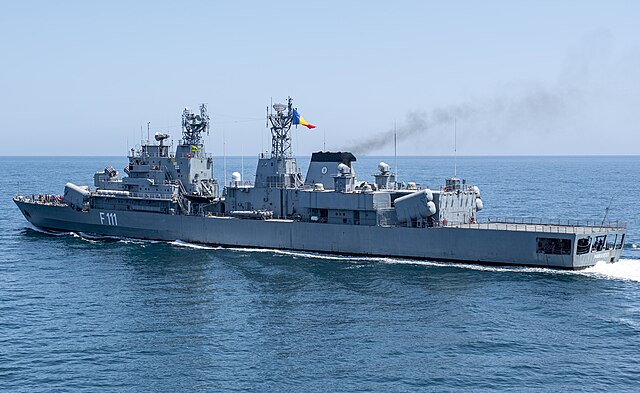
Read More/Src
Books
Breyer, Siegfried (1996). “Flagowiec Nicolae Ceausescu”. Okręty Wojenne (in Polish). Vol. 16/1996. Tarnowskie Góry.
Ciślak, Jarosław (1995). Polska Marynarka Wojenna 1995: okręty, samoloty i śmigłowce, uzbrojenie, organizacja (in Polish). Lampart i Bellona.
Grotnik, Tomasz (July 2007). “Mărăşeşti. Stara fregata w nowej roli”. Nowa Technika Wojskowa (in Polish). Vol. 10/2007. Magnum-X.
Petlevanny, M. B. (2009). Корабли стран Варшавского договора (in Russian). Saint Petersburg: Galeya Print.
Zabłockij, Władymir (2004). “Rumuńskie fregaty typu Tetal-II”. Okręty Wojenne (in Polish). Vol. 2/2004, XIV
Saunders, Stephen, ed. (2002). Jane’s Fighting Ships 2002–2003. Jane’s Information Group Ltd.
Conway’s all the world’s fighting ships 1947-95 page 325.
Links
rumaniamilitary.ro/
en.topwar.ru
www.seaforces.org
navypedia.org/ ro_dd_muntenia.htm
http://jurnalul.ro/
http://marinarii.ro/
navy.ro/ F111.php
web.archive.org marinarii.ro fotografia-5021
marinarii.ro fregata-marasesti-f-111/
en.wikipedia.org/
ro.wikipedia.org/
Videos
Model Kits
None found
3D
None found

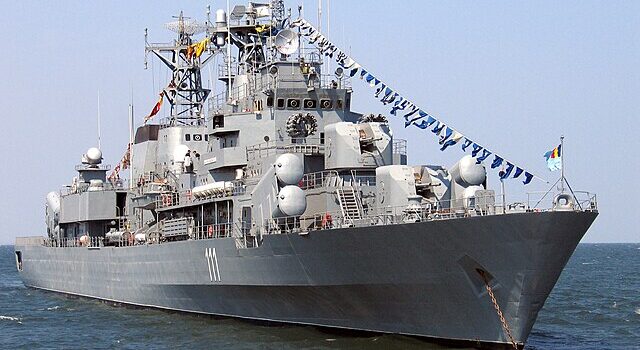
 Latest Facebook Entry -
Latest Facebook Entry -  X(Tweeter) Naval Encyclopedia's deck archive
X(Tweeter) Naval Encyclopedia's deck archive Instagram (@navalencyc)
Instagram (@navalencyc)





 French Navy
French Navy Royal Navy
Royal Navy Russian Navy
Russian Navy Armada Espanola
Armada Espanola Austrian Navy
Austrian Navy K.u.K. Kriegsmarine
K.u.K. Kriegsmarine Dansk Marine
Dansk Marine Nautiko Hellenon
Nautiko Hellenon Koninklije Marine 1870
Koninklije Marine 1870 Marinha do Brasil
Marinha do Brasil Osmanlı Donanması
Osmanlı Donanması Marina Do Peru
Marina Do Peru Marinha do Portugal
Marinha do Portugal Regia Marina 1870
Regia Marina 1870 Nihhon Kaigun 1870
Nihhon Kaigun 1870 Preußische Marine 1870
Preußische Marine 1870 Russkiy Flot 1870
Russkiy Flot 1870 Svenska marinen
Svenska marinen Søværnet
Søværnet Union Navy
Union Navy Confederate Navy
Confederate Navy Armada de Argentina
Armada de Argentina Imperial Chinese Navy
Imperial Chinese Navy Marinha do Portugal
Marinha do Portugal Mexico
Mexico Kaiserliche Marine
Kaiserliche Marine 1898 US Navy
1898 US Navy Sovietskiy Flot
Sovietskiy Flot Royal Canadian Navy
Royal Canadian Navy Royal Australian Navy
Royal Australian Navy RNZN Fleet
RNZN Fleet Chinese Navy 1937
Chinese Navy 1937 Kriegsmarine
Kriegsmarine Chilean Navy
Chilean Navy Danish Navy
Danish Navy Finnish Navy
Finnish Navy Hellenic Navy
Hellenic Navy Polish Navy
Polish Navy Romanian Navy
Romanian Navy Turkish Navy
Turkish Navy Royal Yugoslav Navy
Royal Yugoslav Navy Royal Thai Navy
Royal Thai Navy Minor Navies
Minor Navies Albania
Albania Austria
Austria Belgium
Belgium Columbia
Columbia Costa Rica
Costa Rica Cuba
Cuba Czechoslovakia
Czechoslovakia Dominican Republic
Dominican Republic Haiti
Haiti Hungary
Hungary Honduras
Honduras Estonia
Estonia Iceland
Iceland Eire
Eire Equador
Equador Iran
Iran Iraq
Iraq Latvia
Latvia Liberia
Liberia Lithuania
Lithuania Mandchukuo
Mandchukuo Morocco
Morocco Nicaragua
Nicaragua Persia
Persia San Salvador
San Salvador Sarawak
Sarawak Uruguay
Uruguay Venezuela
Venezuela Zanzibar
Zanzibar Warsaw Pact Navies
Warsaw Pact Navies Bulgaria
Bulgaria Hungary
Hungary

 Bundesmarine
Bundesmarine Dutch Navy
Dutch Navy Hellenic Navy
Hellenic Navy Marina Militare
Marina Militare Yugoslav Navy
Yugoslav Navy Chinese Navy
Chinese Navy Indian Navy
Indian Navy Indonesian Navy
Indonesian Navy JMSDF
JMSDF North Korean Navy
North Korean Navy Pakistani Navy
Pakistani Navy Philippines Navy
Philippines Navy ROKN
ROKN Rep. of Singapore Navy
Rep. of Singapore Navy Taiwanese Navy
Taiwanese Navy IDF Navy
IDF Navy Saudi Navy
Saudi Navy Royal New Zealand Navy
Royal New Zealand Navy Egyptian Navy
Egyptian Navy South African Navy
South African Navy






























 Ukrainian Navy
Ukrainian Navy dbodesign
dbodesign